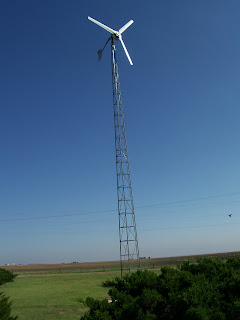Texas may not be the "Show Me" state, but we sure do seem to be showing the rest of the nation how to do wind energy. Texas has become an example of how to move forward with wind energy development. One of the ways we are planning for and making future development possible is by expanding our build-out of transmission lines to reach the windy regions of West Texas.
Class 4 Winds, a wind advocacy group based in Amarillo, Texas recently held a seminar entitled: Transmission - Where We Are Now. The event featured speakers from numerous entities involved with the transmission build out in Texas, some of the them with the CREZ (Competitive Renewable Energy Zones) process and some involved with other plans to make the transmission of wind energy out of the Panhandle of Texas much simpler.
Those who spoke on the current status of CREZ included:
Speaking on other current transmission projects in the area were:
Speaking on other various topics were:
I want to share with you a couple of the major things I took from the event. I'll have a more detailed description of the seminar in our monthly newsletter. You can also check Class 4 Winds' Web site; they should have copies of each presentation posted on their site sometime this week. I'll go over two important topics here today...
TOPIC #1 - Protesting and InterveningTwo different ways you can be involved in the PUCT's process for deciding transmission routesProgress is being made in the planning of the transmission lines for the panhandle and it's important to know how you can be involved. Both Sharyland Utilities and Cross Texas Transmission are in the process of preparing their Certificates of Convenience and Necessity (CCNs) to submit to the PUCT (sidenote: if you are new to this blog/transmission development and curious as to how this process works check out this earlier
post). You can find the deadline dates for CCN filings for each line segment that each Transmission Service Provider (TSP) is building on their respective Web sites. Most recently Cross Texas filed their first CCN on Monday May 3rd for their Gray to Tesla line.
Moving on to the point of this topic, it's important for landowners to know that they can be involved while this process is taking place. And there are two primary ways to do so outside of talking with the individual TSPs, essentially filing informal comments as a protestor and actually intervening in a case.
Basically, as a protestor you simply submit a verbal or written statement to the PUCT outlining your support or opposition of a specific project. On the other hand, to intervene in a case you must request intervenor status. This status is usually only granted to landowners who are directly affected by a line. As an intervenor you will be involved in the process in much more depth. You can find more information about the procedure involved with intervening in this
brochure put out by the PUCT. It is recommended that intervenors have an attorney to help them with the process.
You can find all the forms necessary for being involved as either a protestor or intervenor on the PUCT's Web site (
http://www.puc.state.tx.us/electric/forms/index.cfm)
TOPIC #2 - May 21st - A Final HurdleDevelopers deadline to post Collateral for Panhandle wind projectsPlease refer to this earlier
post for background on developer financial commitments for the panhandle CREZ if you don't know what has happened to date with this process, if you are familiar with the topic then read on...
These financial commitments that need to be made by developers working in the Panhandle seem to be the final hurdle. Once we get past this last hurdle then the rest of the transmission build-out should be rather smooth sailing.
Ten developers in the region have filed an intent to post collateral, all of them for a various number of Megawatts (MWs). At $10,000/MW it equaled out to approximately $126 million. An interim order was signed on April 21st of this year and the deadline for the developers to make the commitment is May 21, 2010. And if you didn't notice, that's coming up real soon. Be checking back from updates.
What's my conclusion?Texas is showing the nation what it takes to be the state with the most wind energy development. Transmission build-out is moving forward, so stay informed and stay involved. Check back here for new information periodically.
You can always submit an anonymous question for us on our formspring page. Check it out, I'll be happy to answer any relevant inquires:
www.formspring.me/cpwea
Until Next time...








